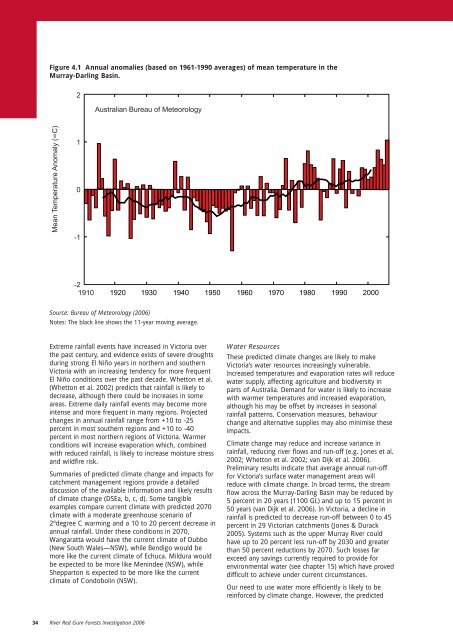Discussion Paper - Part A - Victorian Environmental Assessment ...
Discussion Paper - Part A - Victorian Environmental Assessment ...
Discussion Paper - Part A - Victorian Environmental Assessment ...
- No tags were found...
Create successful ePaper yourself
Turn your PDF publications into a flip-book with our unique Google optimized e-Paper software.
Figure 4.1 Annual anomalies (based on 1961-1990 averages) of mean temperature in theMurray-Darling Basin.2Australian Bureau of MeteorologyMean Temperature Anomaly (∞C)10-1-21910 1920 1930 1940 1950 1960 1970 1980 1990 2000Source: Bureau of Meteorology (2006)Notes: The black line shows the 11-year moving average.Extreme rainfall events have increased in Victoria overthe past century, and evidence exists of severe droughtsduring strong El Niño years in northern and southernVictoria with an increasing tendency for more frequentEl Niño conditions over the past decade. Whetton et al.(Whetton et al. 2002) predicts that rainfall is likely todecrease, although there could be increases in someareas. Extreme daily rainfall events may become moreintense and more frequent in many regions. Projectedchanges in annual rainfall range from +10 to -25percent in most southern regions and +10 to -40percent in most northern regions of Victoria. Warmerconditions will increase evaporation which, combinedwith reduced rainfall, is likely to increase moisture stressand wildfire risk.Summaries of predicted climate change and impacts forcatchment management regions provide a detaileddiscussion of the available information and likely resultsof climate change (DSEa, b, c, d). Some tangibleexamples compare current climate with predicted 2070climate with a moderate greenhouse scenario of2ºdegree C warming and a 10 to 20 percent decrease inannual rainfall. Under these conditions in 2070,Wangaratta would have the current climate of Dubbo(New South Wales—NSW), while Bendigo would bemore like the current climate of Echuca. Mildura wouldbe expected to be more like Menindee (NSW), whileShepparton is expected to be more like the currentclimate of Condobolin (NSW).Water ResourcesThese predicted climate changes are likely to makeVictoria’s water resources increasingly vulnerable.Increased temperatures and evaporation rates will reducewater supply, affecting agriculture and biodiversity inparts of Australia. Demand for water is likely to increasewith warmer temperatures and increased evaporation,although his may be offset by increases in seasonalrainfall patterns. Conservation measures, behaviourchange and alternative supplies may also minimise theseimpacts.Climate change may reduce and increase variance inrainfall, reducing river flows and run-off (e.g. Jones et al.2002; Whetton et al. 2002; van Dijk et al. 2006).Preliminary results indicate that average annual run-offfor Victoria’s surface water management areas willreduce with climate change. In broad terms, the streamflow across the Murray-Darling Basin may be reduced by5 percent in 20 years (1100 GL) and up to 15 percent in50 years (van Dijk et al. 2006). In Victoria, a decline inrainfall is predicted to decrease run-off between 0 to 45percent in 29 <strong>Victorian</strong> catchments (Jones & Durack2005). Systems such as the upper Murray River couldhave up to 20 percent less run-off by 2030 and greaterthan 50 percent reductions by 2070. Such losses farexceed any savings currently required to provide forenvironmental water (see chapter 15) which have proveddifficult to achieve under current circumstances.Our need to use water more efficiently is likely to bereinforced by climate change. However, the predicted34 River Red Gum Forests Investigation 2006
















